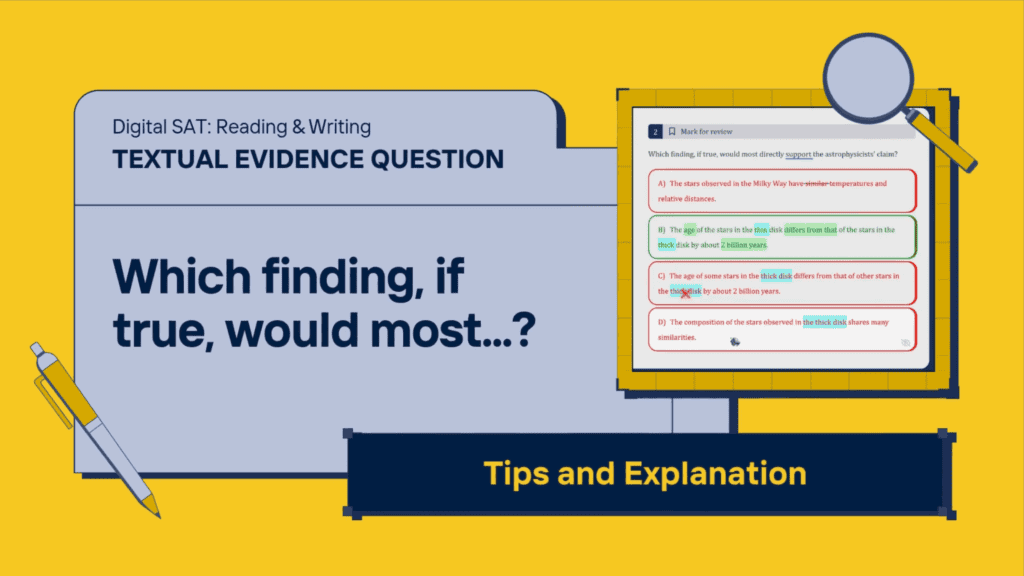Textual Evidence Questions
For Textual Evidence Questions on DSAT Reading and Writing (English section), always read the question sentence first. The goal here is to look for the word “support.”
“Which finding, if true, would most directly support the astrophysicists’ claim?”
Your job is to figure out which answer choice backs up the idea stated in the passage.
Scientific Study Specifics
Since it’s research, the chances are you have to understand how a factor contributes to the data being collected. It basically means there will be comparison between groups and specific patterns will (or will not, based on the question sentence) emerge in specific groups. Your goal is to understand it and see the pattern.
Get What the Claim Is Really Saying
You should initially skim through the passage and focus on what conclusion or finding is expected. This is often written in one sentence, which we call the claim sentence. And when you have identified the factors and pattern of data, go back to the passage and read carefully what data is measured for which factor. For this particular question, here’s what you need to do:
- Spot the Claim: The claim here is that the Milky Way’s disk has two different phases, which correspond to different regions.
- Identify Factors and Patterns: Notice that the scientists figured this out by looking at how old the stars are in different parts of the galaxy. Age is a big deal here. So in another word, age group one corresponds to region one, and age group two corresponds to region two.
Pro Tip: Underline or circle key words like “two phases,” “distinct regions,” and “ages of the stars.” These will help you zero in on what matters most.
Break Down the Answer Choices
Now let’s check out the choices one by one.
Choice A:
“The stars observed in the Milky Way have similar temperatures and relative distances.”
- Why It Doesn’t Work: This choice talks about temperatures and distances, not the age differences that the claim is all about. If everything’s similar, you’re not getting the clear split that supports two phases.
Choice B:
“The age of the stars in the thin disk differs from that of the stars in the thick disk by about 2 billion years.”
- Why It Works: This answer nails it because it directly compares two different regions (the thin disk vs. the thick disk) using their ages. This clear age gap is exactly the kind of evidence that backs up the claim.
Choice C:
“The age of some stars in the thick disk differs from that of other stars in the thick disk by about 2 billion years.”
- What’s Wrong: This one only looks at differences within the thick disk. It doesn’t give you the comparison between two different regions, so it’s not really supporting the claim about distinct formation phases.
Choice D:
“The composition of the stars observed in the thick disk shares many similarities.”
- Why It Falls Short: This answer is about the chemical makeup of stars in just one region and doesn’t touch on the age differences or the comparison between two regions. It’s off-track from the claim.
Some Strategies that Also Work
- For this question, three out of four choices mention the disks, so at this point, you should be able to see the significance of disk, especially thin vs. thick disk. Sometimes comparing the focus of the choices can really give you some insight.
- If you’ve done this type of question multiple times, you can actually predict the pattern before you read the choices. But do not try this when you struggle to understand the research. If you don’t understand the claim, you can’t predict the pattern. And moving on to the choices at this point might actually help you see the factors and pattern more clearly!
- Always try to rephrase the claim in your own words to see if you truly understand it.
Final Thoughts
Remember, breaking down SAT textual questions is all about understanding what the claim is. By focusing on the factors and pattern—like the age differences in our example—you can quickly figure out which answer supports/weakens the claim.
Keep practicing this method:
- Look for the word “support” or “weaken” in the questions sentence
- Skim to locate the claim
- Understand the pattern being described
- Take your time understanding the methodology
Did you know we have FREE SAT English questions and weakness analysis?
In fact, this very question is from our Free SAT Reading & Writing Quiz. Analyze your skills in Reading & Writing, and discover your study focus. Complete the free questions and receive a full report of your strengths and weaknesses.
#satengtips #digitalsat #sat #dsat #satprep #sattips #sathacks #satstrategies #satenglish #satreading

